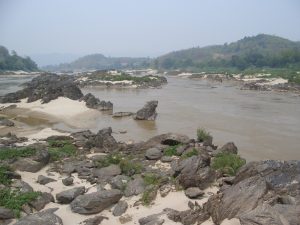By Sebastian Strangio

China has agreed to provide the Mekong River Commission (MRC) with year-round hydrological data, following through on a promise made by Chinese Premier Li Keqiang in August.
According to an MRC statement, the agreement was signed on October 22 between China’s Ministry of Water Resources and the four-nation commission during a one-day virtual MRC Dialogue Partners Meeting. The meeting is held once a year between the MRC – which counts Vietnam, Cambodia, Laos and Thailand as members – and its two upstream dialogue partners, China and Myanmar.
Since 2002, China has shared water level and rainfall data during the annual June-October flood season, but will now share data from the whole year. Dr. An Pich Hatda, the MRC Secretariat Chief Executive Officer, hailed the agreement as “a landmark in the history of China-MRC cooperation.” He added: “The increased regulation of the basin and the opportunities and challenges it brings calls for greater data and information sharing, improved water release notifications, coordination of operations, and enhanced early warning systems.”
The agreement comes after a year in which China’s development of the upper Mekong, known in China as the Lancang, has come under close international scrutiny. In particular, critics allege that China’s 11 large hydropower dams on the upper Mekong have exacerbated droughts in the lower Mekong countries by preventing much-needed water from flowing downstream. This year, the river has been hit by a severe drought, which has resulted in record low fish catches in some downstream countries. This followed on the heels of a previous record dry-spell in 2016.
An April 2020 report from Eyes on Earth, a U.S.-based research and consulting firm, found a yawning mismatch between the recent volume of rainfall on the Chinese portion of the Mekong and the water levels downstream. “For six months in 2019, while China received above average precipitation,” it concluded, “its dams held back more water than ever – even as downstream countries suffered through an unprecedented drought.”
The report’s conclusion was quickly taken up by the Trump administration, with senior U.S. officials assailing Beijing for “hoarding” the river’s water. It prompted China to issue its own report disputing Eyes on Earth’s findings, and for Premier Li Keqiang to promise to share more hydrological data with downstream nations.
While the MRC has published its own report refuting the claim that China was responsible for the 2019 drought (some aspects of the Eyes on Earth report have also been questioned by independent researchers) it did fault China for not providing enough data and information on its stretch of the river. “China should consider providing more data that covers more stations and includes the dry season,” the MRC stated. Speaking at the annual leader’s meeting of the China-led Lancang-Mekong Cooperation (LMC) platform in August, Li Keqiang pledged that “Starting from this year, China will share the Lancang River’s hydrological data for the whole year with the Mekong countries.”
China’s Lancang dams, the first of which was completed in 1994, have given it significant strategic leverage over downstream nations. After leaving China’s Yunnan province, the Mekong flows through five ASEAN member states, where it is central to the livelihoods of more than 60 million people. Knowing that Chinese dam engineers effectively control their access to a life-giving resource will surely make downstream nations think twice before opposing Chinese objectives in the region.
Given the controversy that has surrounded China’s dam-building, and the way that the issue has been taken up by the Trump administration to attack Beijing, it was only logical that China would seek to mollify the concerns of downstream nations. After all, it is in the Chinese government’s interests to be on good terms with its neighbors in mainland Southeast Asia, to the extent possible.
This, in essence, is the purpose of the LMC, which China launched in 2016 in order to spearhead its engagement with the five nations of mainland Southeast Asia. Unlike the MRC, which focuses mostly on river management (and of which China is not a member), the LMC has been shaped into a full-blown sub-pillar of the Belt and Road Initiative (BRI), designed to deepen the integration of China and mainland Southeast Asia via the construction of a welter of new highways, rail lines and special economic zones.
As my colleague Shannon Tiezzi noted in August, after Premier Li announced China’s intention to share year-round data with downstream nations, “The LMC is serving its desired purpose for both sides: It gives China a platform to paint itself as the hero, rather than the villain, in the Mekong story and gives Southeast Asian countries a valuable chance to directly speak to China on the health of their shared river.”
As such, the deal between China and the MRC could well lead to real improvements for the millions who rely upon the mighty river for livelihoods or sustenance. The catch is that all of these efforts will take place at Beijing’s sufferance.
No comments:
Post a Comment